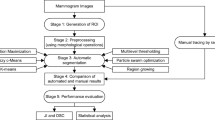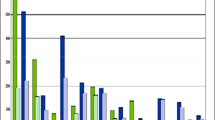Abstract
Breast cancer is becoming the leading form of cancer among women worldwide, indeed, there are no effective ways to prevent this disease at present, therefore, it’s early screening and detection is the key to rise the success of treatment, hence, the reduce of the associated mortality rates. This work aims to improve the performance of the current computer-aided detection and diagnosis approaches (CADe/CADx) of breast cancer which involve the application of the computer technology in mammograms analysis and understanding; for this purpose, we deal with the power laws: Zipf and inverse Zipf. The originality of this research lays in the contribution of the power laws for mammograms analysis; it is the first attempt to use them in the field of mammograms masses segmentation and classification, indeed, these laws characterize the structural complexity of texture within mammograms and provide the curves of Zipf and inverse Zipf which carry significant information that could be used to mammograms masses detection and classification along a new set of textural features extracted from the curves of Zipf and inverse Zipf. According to our experiments conducted on a mammogram database used in the framework of a bilateral project between our university and the hospital CHU at Algeria, we can assert that our approach based Zipf’s and inverse Zipf’s laws is a powerful and efficient approach for automated mammograms masses detection and classification.







Similar content being viewed by others
Explore related subjects
Discover the latest articles, news and stories from top researchers in related subjects.References
Adamic LA, Huberman BA (2002) Zipf’s law and the Internet, Glottometrics 3: 143–15
Bezdek JC (1981) Pattern recognition with fuzzy objective function algorithms. Plenum Press, New York Tariq Rashid: “Clustering”
Bi D (1997) Segmentation d’images basée sur les statistiques de rangs des niveaux de gris, PhD thesis, Université de Tours, Javier
Bordignon F, Gomide F (2014) Uninorm based evolving neural networks and approximation capabilities. Neuro comput 127:13–20
Bozek J, Mustra M, Delac K, Grgic M. (2009) A survey of image processing algorithms in digital mammography. advanced. In multimedia. signal. processing. and communication., SCI 231 631–657
Burgos JD, Moreno-Tovar P (1996) Zipf-scaling behavior in the immune system. BioSystems 39:227–232
Cao A, Song Q, Yang X (2008) Robust information clustering incorporating spatial information for breast mass detection in digitized mammograms. Comput Vis Image Underst 109:86–96
Cao Y, Hao X, Zhu X, Xia S (2010) An adaptive region growing algorithm for breast masses in Mammograms. Front Electr Electron Eng China 5(2):128–136
Caron Y, Makris P, Vincent N (2002) A method for detecting artificial objects in natural environments, Proceedings of International Conference on Pattern recognition (ICPR-IAPR) Québec 600–6003
Caron Y, Makris P, Vincent N (2007) Use of power law models in detecting region of interest. J Pattern Recog 40:2521–2529
Chaira T (2011) A novel intuitionistic fuzzy c-means clustering algorithm and its application to medical images. Appl Soft Comput 11:1711–1717
Chen CH, Lee GG (1997) On digital mammogram segmentation and microcalcification detection using multiresolution wavelet analysis. Gr Model Image Process 59:349–364
Cheng HD, Shi XJ, Min R, Hu LM, Cai XP, Du HN (2006) Approaches for automated detection and classification of masses in mammograms. Pattern Recogn 39:646–668
Cohen A, Mantegna R, Havlin S (1997) Numerical analysis of word frequencies in artificial and natural language texts Fractals-an Interdis- ciplinary. J Complex Geom 5(1):95–104
Dom´ınguez AR, Nandi AK (2008) Detection of masses in mammograms via statistically based enhancement, multilevel-thresholding segmentation, and region selection. Comput Med Imaging Graph 32:304–315
Dua S, Singh H, Thompson HW (2009) Associative classification of mammograms using weighted rules. Expert Syst Appl 36:9250–9259
Dunn JC (1973) A fuzzy relative of the isodata process and its use in detecting compact well-separated clusters. J Cybern 3:32–57
El Saghir NS, Khalil MK, Eid T, El Kinge AR, Charafeddine M, Geara F, Seoud M, Shamseddine AI (2007) Trends in epidemiology and management of breast cancer in developing Arab countries: a literature and registry analysis. Int J Surg 5:225–233
Ferlay J, Shin HR, Bray F, Forman D, Mathers CD, Parkin D (2008) Cancer incidence and mortality worldwide: IARC Cancer Base No. 10. Lyon, France: International Agency for Research on Cancer. GLOBOCAN
Gan L, Li D, Song S (2006) Is the Zipf law spurious in explaining city-size distributions? Econ Letter 92:256–262
Giger ML, Suzuki K (2008) Computer-aided diagnosis (CAD). In: Feng DD (ed) Biomedical information technology, vol 16. Academic Press, New York, NY, pp 359–374
Görgel P, Sertbas A, Ucan ON (2013) Mammographical mass detection and classification using Loca lSeed Region Growing-Spherical Wavelet Transform (LSRG–SWT) hybridscheme. Comput Biol Med 43:765–774
Hamoud M, Merouani HF (2011) Detection of a region of interest in the images based on Zipf laws, in proceedings of the seventh IEEE International Conference on Signal-Image Technology and Internet-Based Systems, Dijon, France. ISBN: 978-0-7695-4635-3
Hanifi M (2009) Extraction de caractéristiques de texture pour la classification d’images satellites, PhD thesis, University of Toulouse III
Haralick RM (1979) Statistical and structural approaches to textures. Proc IEEE 67(5):786–804
Harwood D, Subbarao M, Davis LS (1985) Texture classification by local rank correlation. CVGIP 32:404–411
Hasan H, Abdul-Kareem S (2013) Fingerprint image enhancement and recognition algorithms: a survey. Neural Comput Applic 23:1605–1610
Hou Z, Qian W, Huang S, Hu Q, Nowinski WL (2007) Regularized fuzzy c-means method for brain tissue clustering. Pattern Recogn Lett 28:1788–1794
Jalalian A, Mashohor SBT, Rozi Mahmudb H, Saripan M, Ramli Abdul Rahman B, Karasfi B (2013) Computer-aided detection/diagnosis of breast cancer in mammography and ultrasound: a review. Clin Imaging 37:420–426
Ji Z, Sun Q, Xia Y, Chen Q, Xia D, Feng D (2012) Generalized rough fuzzy c-means algorithm for brain MR image segmentation. Comput Method Program Biomed 108:644–655
Kalinin VM (1964) Razvitie schemy Puassona i ee primenenie dlja statisticeskich svojstv reci, Leningrad
Kang B-Y, Kim D-W (2010) VS-FCM: validity-guided spatial fuzzy c-means clustering for image segmentation. Int J Fuzzy Logic Intell Sys 10:89–93
Kannan SR, Ramathilagam S, Devi R, Hines E (2012) Strong fuzzy c-means in medical image data analysis. J Syst Softw 85:2425–2438
Li W, Yang Y (2002) Zipf’s law in importance of genes for cancer classification using microarray data. J Theor Biol 219:539–551
Li X, Williams S, Bottema MJ (2013) Background intensity independent texture features for assessing breast cancer risk in screening mammograms. Pattern Recogn Lett 34:1053–1062
Lladó X, Oliver A, Freixenet J, Martí R, Martí J (2009) A textural approach for mass false positive reduction in mammography. Comput Med Imaging Graph 33:415–422
Lua KT (1994) Frequency-rank curves and entropy for Chinese characters and words. Comput Process Chinese Orient Lang 8:37–52
Mavroforakis ME, Georgiou HV, Dimitropoulos N, Cavouras D, Theodoridis S (2006) Mammographic masses characterization based on localized texture and dataset fractal analysis using linear, neural and support vector machine classifiers. Artif Intell Med 37:145–162
Melouah A (2013) A novel region growing segmentation algorithm for mass extraction in mammograms. Amine et al. (Eds.): modeling approaches and algorithms, SCI 488: 95–104
Merouani HF (1999) A Markov Random Field approach to the analysis of texture in digitized mammograms. In PHD thesis. Robert Gordon University Aberdeen UK
Minh-Nguyen T, Jonathan-Wu QM (2013) A fuzzy logic model based Markov random field for medical image segmentation. Evol Syst 4:171–181
Moayedi F, Azimifar Z, Boostani R, Katebi S (2010) Contourlet-based mammography mass classification using the SVM family. Comput Biol Med 40:373–383
Mohammad A, Kim HJ (2013a) An enhanced fuzzy c-means algorithm for audio segmentation and classification. Multimed Tools Appl 63:485–500
Mohammad A, Kim HJ (2013b) An analysis of content-based classification of audio signals using a fuzzy c-means algorithm. Multimed Tools Appl 63:77–92
Mudigonda RN, Rangayyan MR, Desautels JEL (2000) Gradient and texture analysis for the classification of mammographic masses. IEEE Trans Med Imaging 19:1032–1043
Mújica-Vargas D, Gallegos-Funes FJ, Rosales-Silva AJ, Rubio JJ (2013) Robust c-prototypes algorithms for color image segmentation EURASIP. J Image Video Process 2013(63):1–12
Najjar H, Easson A (2010) Age at diagnosis of breast cancer in Arab nations. Int J Surg 8:448–452
Nakagawa T, Hara T, Fujita H, Horita K, Iwase T, Endo T (2008) Radial-searching contour extraction method based on a modified active contour model for mammographic masses. Radiol Phys Technol 1:151–161
Oliver A, Freixenet J, Marti J, Pérez E, Pont J, Denton ERE, Zwiggelaar R (2010) A review of automatic mass detection and segmentation in mammographic images. Med Image Anal 14:87–110
Patel D, Stoneham TJ (1992) Texture image classification and segmentation using rankorder clustering, Proc. 11th TCPR, Den Haag
PÉROT G (1972) Mot et image : les mêmes lois statistiques, revue de ‘Communication et Langage’
Pinto Carla MA, Mendes Lopes A, Tenreiro Machado JA (2012) A review of power laws in real life phenomena. Commun Nonlinear Sci Numer Simulat 17:3558–3578
Rabottino G, Mencattini A, Salmeri M, Caselli F, Lojacono R (2011) Performance evaluation of a region growing procedure for mammographic breast lesion identification. Comput Stand Interface 33:128–135
Rahmati P, Adler A, Hamarneh G (2012) Mammography segmentation with maximum likelihood active contours. Med Image Anal 16:1167–1186
Ramos RP, Zanchetta do Nascimento A, Cesar Pereira D (2012) Texture extraction: an evaluation of ridgelet, wavelet and co-occurrence based methods applied to mammograms. Expert Syst Appl 39:11036–11047
Rangayyan Rangaraj M, Ayres Fabio J, Leo Desautels JE (2007) A review of computer-aided diagnosis of breast cancer: toward the detection of subtle signs. J Franklin Inst 344:312–348
Rubio JJ (2014) Adaptive least square control in discrete time of robotic arms. Soft Comput. doi:10.1007/s00500-014-1300-2
Sampaio WB, Diniz EM, Silva a AC, Cardoso de Paiva A, Gattass M (2011) Detection of masses in mammogram images using CNN, geostatistic functions and SVM. Comput Biol Med 41:653–664
Suliga M, Deklerck R, Nyssen E (2008) Markov random field-based clustering applied to the segmentation of masses in digital mammograms. Comput Med Imaging Graph 32:502–512
Vázquez DM, Rubio JJ, Pacheco J (2012) Characterization framework for epileptic signals. IET Image Proc 6(9):1227–1235
Verma B, McLeod P, Klevansky A (2010) Classification of benign and malignant patterns in digital mammograms for the diagnosis of breast cancer. Expert Syst Appl 37:3344–3351
Wang L, He DC (1990) Texture classification using texture spectrum. Pattern Recogn 23:905–910
Wang Y, Gao X, Li X, Tao D, Wang B (2009) Embedded geometric active contour with shape constraint for mass segmentation. CAIP LNCS 5702:995–1002
Winsberg F, Elkin M, Macy J, Bordaz V, Weymouth W (1967) Detection of radiographic abnormalities in mammograms by means of optical scanning and computer analysis. Radiology 89(2):211–215
Zhang Y, Xie F, Huang D, Ji M (2010) Support vector classifier based on fuzzy c means and Mahalanobis distance. J Intell Inf Syst 35:333–345
Zheng L, Andrew Chan K, McCord G, Wu S, Steve Liu J (1999) Detection of cancerous masses for screening mammography using discrete wavelet transform-based multiresolution markov random field. J Dig lmaging 12:18–23
Zipf GK (1949) Human behavior and the principle of least effort. Addison- Wesley, Reading
Author information
Authors and Affiliations
Corresponding author
Electronic supplementary material
Below is the link to the electronic supplementary material.
Rights and permissions
About this article
Cite this article
Hamoud, M., Merouani, H.F. & Laimeche, L. The power laws: Zipf and inverse Zipf for automated segmentation and classification of masses within mammograms. Evolving Systems 6, 209–227 (2015). https://doi.org/10.1007/s12530-014-9116-y
Received:
Accepted:
Published:
Issue Date:
DOI: https://doi.org/10.1007/s12530-014-9116-y




